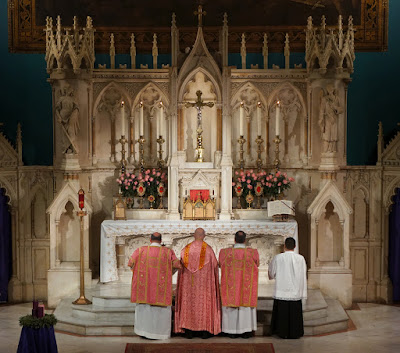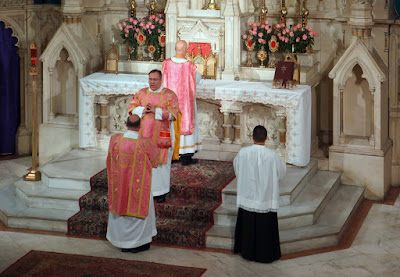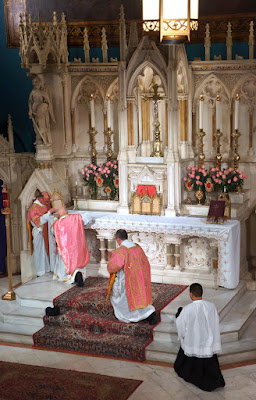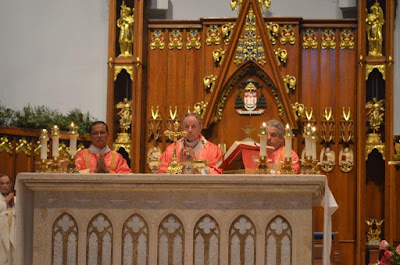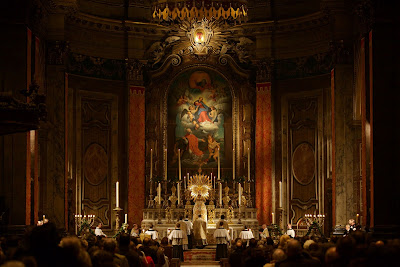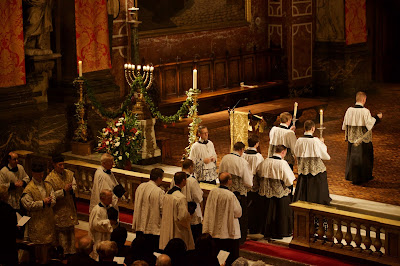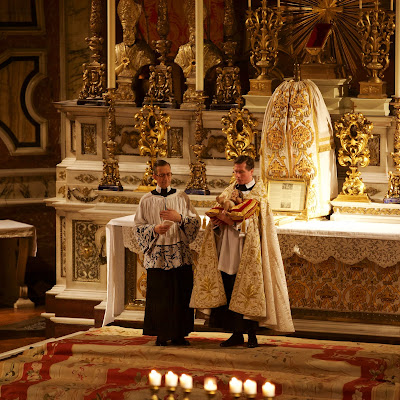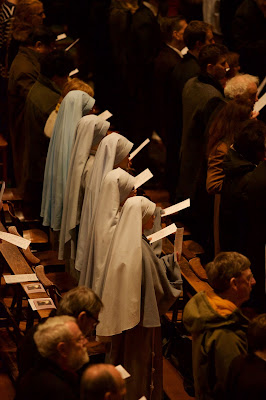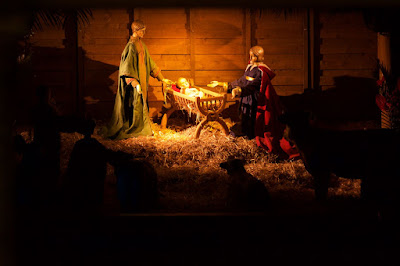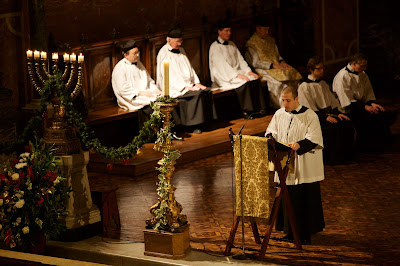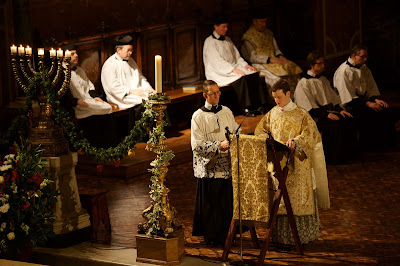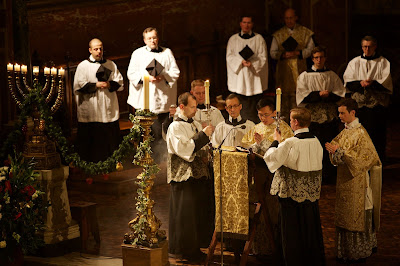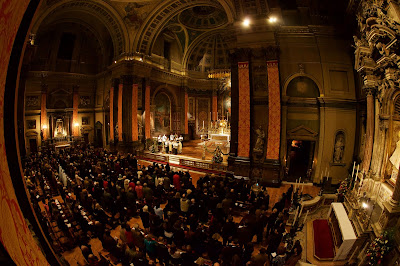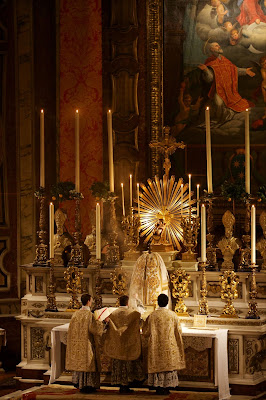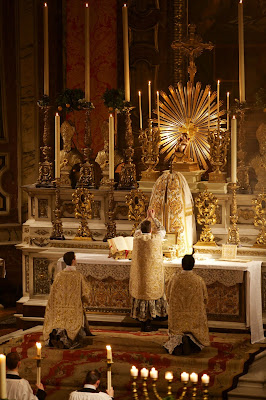The Second Vatican Council’s constitution on the Sacred Liturgy,
Sacrosanctum Concilium, says precisely nothing about the Preface of the Mass. However, there can be no doubt that its revision was on the minds of the liturgists, and had been for some time, even if it was not on the minds of the Council Fathers. The trend towards expanding the very limited traditional corpus had been growing for some time; in 1919, Pope Benedict XV added the Neo-Gallican preface for the Requiem Mass to the Roman Missal, along with a newly composed one for St Joseph, modelled on that of the Virgin Mary. He was followed in this trend by Pius XI, who added others for the feasts of the Sacred Heart and Christ the King, followed by Pius XII, who added one for the newly invented Chrism Mass in his Holy Week reform. In the same period, some religious orders adopted new Prefaces for their founders or other prominent Saints, such as
the one for St Dominic added to the Dominican Missal in 1921.
The influence of the Ambrosian Liturgy (
whether correctly understood or not) and
the Neo-Gallican uses was quite strong on the creators of the post-Conciliar liturgical reform. It might therefore be assumed that when the decision was made to add a Preface for Advent for general use in the Roman Rite, the most obvious choice would be
the Neo-Gallican Preface already widely used in France, Belgium and elsewhere. Since in fact two such Prefaces were added, one to be said up until December 16th, and the second for rest of the season, a logical second choice would be the
Ambrosian Preface for the major ferias “de Exceptato” at the end of the Milanese Advent, or possibly one of the eight other options in the Ambrosian Missal.
Inexplicably,
but not surprisingly, none of the Prefaces for Advent then in use in the Latin Rites was in fact chosen. In May of 1968, the Sacred Congregation for Rites issued eight new Prefaces, including two for Advent, both of which were carried over into the Novus Ordo when it was promulgated a year and half later. These are partly
ex novo compositions, and partly the result of the often rather bizarre process known as “centonization”, the compilation of fragments and phrases taken from a variety of sources, often no more than a word or two.
In 1989, Frs Anthony Ward SM and Cuthbert Johnson OSB published
The Prefaces of the Roman Missal (Centro Liturgico Vincenziano, Rome), which meticulously documents the origins (liturgical, scriptural, and patristic) of all 81 of the Novus Ordo Prefaces. The Neo-Gallican and the Ambrosian Advent Prefaces are not even cited in either of the new Advent Prefaces; the sources for the first are mostly texts originally used on the Ascension, and those of the second are from Christmas and the birth of St John the Baptist. Johnson and Ward do however note the presence of the word “pervigiles – ever watchful” in the second one as a reference to the Collect of a Mass for Advent in the Gelasian Sacramentary.
![]() |
| The beginning of the Gelasian Sacramentary in the Vatican Library manuscript Reginensis 316. (Public domain image from Wikipedia.) |
We conclude this series with the original Latin texts of these two Prefaces, each of which (in accordance with the
methodus zuhlsdorfiana, a.k.a. What Does the Preface Really Say?) is followed by my own literal translation, the old ICEL translation (whose defects are displayed in a particularly glaring light in the first one), and the new translation, which today finishes its fifth Advent. (The earlier parts of this series may be read at the following links:
Ambrosian 1,
Ambrosian 2,
Ambrosian 3,
Neo-Gallican.)
The First Preface of Advent
(said from the First Sunday until December 16)
VD: Qui, primo adventu in humilitáte carnis assumptae, dispositiónis antíquae munus implévit, nobisque salútis perpétuae trámitem reserávit: ut, cum secundo vénerit in suae gloria maiestátis, manifesto demum múnere capiámus, quod vigilantes nunc audémus exspectáre promissum. Et ídeo.
My translation: Truly … through Christ our Lord. Who by His first coming in the humility of the flesh which He took on, fulfilled the duty (laid upon Him by Thy) ancient dispensation, and opened for us the way of eternal salvation; so that, when He comes again in the glory of His majesty, we may at last receive of His gift made manifest the promise which we now dare to hope and watch for. And therefore…
Old translation: When he humbled himself to come among us as a man, he fulfilled the plan you formed long ago and opened for us the way to salvation. Now we watch for the day, hoping that the salvation promised us will be ours when Christ our Lord will come again in his glory.
New translation: For he assumed at his first coming the lowliness of human flesh, and so fulfilled the design you formed long ago, and opened for us the way to eternal salvation, that, when he comes again in glory and majesty and all is at last made manifest, we who watch for that day may inherit the great promise in which now we dare to hope.
The Second Preface of Advent
(said from December 17 until the morning Mass of December 24)
VD: Quem praedixérunt cunctórum praeconia prophetárum, Virgo Mater ineffábili dilectióne sustínuit, Ioannes cécinit affutúrum et adesse monstrávit. Qui suae nativitátis mysterium tríbuit nos praeveníre gaudentes, ut et in oratióne pervígiles, et in suis inveniat láudibus exsultantes. Et ídeo.
My translation: Truly … through Christ our Lord. Whom the proclamations of all the prophets foretold, whom the Virgin Mother bore and raised with love beyond all telling, whom John (the Baptist) prophesied would come, and showed when He came. Who granted to us to come with rejoicing before the mystery of His Birth, that He may find us ever-watchful in prayer, and exultant in His praises. And therefore…
Old translation: His future coming was proclaimed by all the prophets. The virgin mother bore him in her womb with love beyond all telling. John the Baptist was his herald and made him known when at last he came. In his love Christ has filled us with joy as we prepare to celebrate his birth, so that when he comes he may find us watching in prayer, our hearts filled with wonder and praise.
New translation: For all the oracles of the prophets foretold him, the Virgin Mother longed for him with love beyond all telling, John the Baptist sang of his coming and proclaimed his presence when he came. It is by his gift that already we rejoice at the mystery of his Nativity, so that he may find us watchful in prayer and exultant in his praise.



